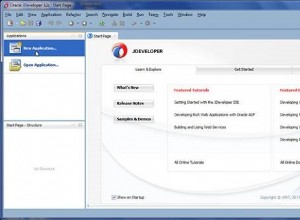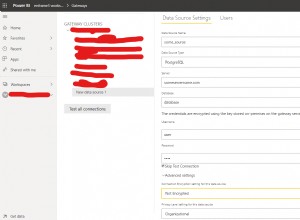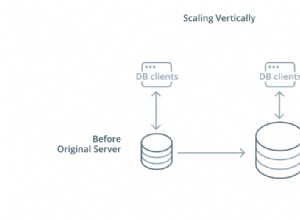đây là T_SQL, giả sử điều này:
- Bạn không biết có bao nhiêu cột có thể xuất hiện trong kết quả.
- Các phần tử Pivot có thể khác nhau (đó là lý do tại sao giả định đầu tiên).
- Bạn cần đơn đặt hàng cụ thể 'ChildId1, ChilDesc1, ChildId2, ChildDesc2 ... càng ngày càng tốt'
DECLARE @ MaxCountOfChild int
-- Obtaining Maximum times a Master is used by its children
SELECT TOP 1 @MaxCountOfChild= count(*)
FROM ChildTable
GROUP BY MasterID
order by count(*) DESC
--With that number, create a string for the Pivot elements
--if you want them in the order Id1-Desc1-Id2-Desc2
DECLARE
@AuxforReplacing nvarchar(MAX),
@ChildIdsandDescs nvarchar(MAX),
@PivotElements nvarchar(MAX),
@Counter int,
@sql nvarchar(MAX)
SET @Counter=0
SET @AuxforReplacing=''
SET @ChildIdsandDescs=''
SET @PivotElements=''
WHILE (@Counter < @MaxCountOfChild)
begin
SET @[email protected] +1
SET @[email protected] + '[' +convert(varchar, @Counter)+ '],'
SET @[email protected] + '[' +convert(varchar, @Counter)+ '] as ' + convert(varchar, @Counter) + ','
SET @[email protected] + '[ChildID' + convert(varchar, @Counter)+ '],[ChildDesc' + convert(varchar, @Counter) +'],'
end
SET @PivotElements=LEFT(@PivotElements, len(@PivotElements)-1)
SET @ChildIdsandDescs=LEFT(@ChildIdsandDescs, len(@ChildIdsandDescs)-1)
SET @AuxforReplacing=LEFT(@AuxforReplacing, len(@AuxforReplacing)-1)
--print REPLACE(@AuxforReplacing, 'as ', 'as ChildId')
--print @ChildIds
--print @PivotElements
SET @sql = N'
WITH AuxTable (Masterdesc,ChildId, MasterId,ChildDesc, NumeroenMaster)
AS
(
SELECT M.Description as MasterDesc, C.*, RANK() OVER (PARTITION BY M.MasterId ORDER BY M.MasterId, ChildId)
FROM MasterTable M
INNER JOIN ChildTable C
ON M.MasterId=C.MasterId
)
SELECT TablaMaster.MasterId,' + @ChildIdsandDescs + '
FROM
(
SELECT MasterId, ' + REPLACE(@AuxforReplacing, 'as ', 'as ChildId') + '
FROM (
SELECT MasterId, NumeroenMaster, ChildId
FROM AuxTable) P
PIVOT
(
MAX (ChildId)
FOR NumeroenMaster IN (' + @PivotElements +')
) AS pvt) As TablaMaster
INNER JOIN
(
SELECT MasterId, ' + REPLACE(@AuxforReplacing, 'as ', 'as ChildDesc') + '
FROM (
SELECT MasterId, NumeroenMaster, ChildDesc
FROM AuxTable) P
PIVOT
(
MAX (ChildDesc)
FOR NumeroenMaster IN (' + @PivotElements +')
) AS pvt) As TablaChild
ON TablaMaster.MasterId= TablaChild.MasterId'
EXEC sp_executesql @sql
CHỈNH SỬA:Kết quả là:
MasterId ChildID1 ChildDesc1 ChildID2 ChildDesc2 ChildID3 ChildDesc3 ChildID4 ChildDesc4
-------- -------- ---------- -------- ----------- -------- ---------- -------- ---------
1 1 Child1 2 Child2 NULL NULL NULL NULL
2 3 Child3 4 Child4 7 Child7 8 Child8
3 5 Child5 6 Child5 NULL NULL NULL NULL
Asumming this in the table ChildTable:
ChildId MasterId ChildDesc
------- -------- ---------
1 1 Child1
2 1 Child2
3 2 Child3
4 2 Child4
5 3 Child5
6 3 Child5
7 2 Child7
8 2 Child8




